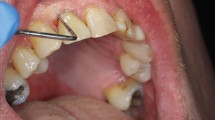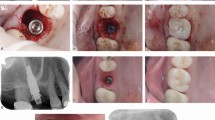Abstract
A review of the management of implants in general practice in relation to the responsibility and liability for managing them when the dentist has not placed the implant themselves.
Key points
General dental practitioners (GDPs) will have responsibility and a duty of care for monitoring the implants in patients who are under their care.
The patient should be made aware of their responsibility to engage in any programme of maintenance established either by the dentist who placed the implants, or the GDP.
There are guidelines and clinical journal articles for GDPs unfamiliar with implants to assist in managing implant patients.
Similar content being viewed by others
Introduction
It has been reported that the dental implants market was valued at USD $4.5 billion in 2022, with an expected annual growth rate of 6.5% for the next ten years.1 In addition, there are more than 200 manufacturers involved in the production of these medical devices made of titanium or zirconium. Such is the popularity of implants as a treatment option that it is increasingly likely that you will be asked to look after an osseous-integrated implant long after it was originally placed by a clinician that you may never have met, using an unfamiliar system that you may not always recognise.
The excellent long-term survival rates and lower costs involved in treatment have combined with increased levels of patient awareness and understanding of the procedure, such that it is now regarded as a mainstream procedure with reasonably predictable outcomes. Patients may now ask you directly to provide an implant for both cosmetic and functional reasons to replace any teeth that are missing. After a careful medical history and a detailed examination of their mouth, you can decide if their requested treatment lies within your skill set or whether you would prefer to refer them to a colleague.
Having agreed with the patient that you would be happy to look after their desired dental needs, you will be in a position to explain the treatment and the subsequent maintenance that will be required - most importantly, the need for periodic review and daily maintenance of their new implant by the patient themselves. So, just how much responsibility do you have for the ongoing success or failure of any pre-existing implant(s) in the patient's mouth?
The condition of an existing implant
When you discover an existing implant at the time of your initial examination of the patient, you may not always find it in a healthy condition; it could be that since it was originally placed, there have been incremental biological challenges to the implanted structure due to peri-implant disease. In the presence of any deterioration of the tissues supporting the implant, it would be helpful to consider some or all of the following points:
Is the patient already aware of changes in the condition of the implant site?
If you didn't place the implant, how should you now monitor the patient during future routine oral examination?
What if you don't place implants yourself or don't feel confident to monitor them or maintain them?
What if you have seen the patients for many years and had previously advised them not to have an implant because of other related issues but they went to another practice and did it anyway?
What if the patient decided to travel abroad to have their implants done in another country, either in Europe or further afield?
There is an underlying ethical principle that can help you to manage the situations outlined above. You must decide who has a duty of care to the patient who is now asking for you to manage their future dental needs. ‘In most cases, if you are their general dental practitioner (GDP) looking after them and carrying out their routine check-ups, then you will have a duty of care to, at the very least, monitor these implants'.2 In addition, you will have a duty of care for any maintenance of the implant site that might be indicated.
What should the GDP do?
The first step is to establish what is known about the implant in question:
Who placed the implant?
Is there any ongoing care to be provided by the person who placed it (the implantologist)?
The next step is to discover your patient's level of understanding about their implants. ‘All implantologists have a responsibility to make patients aware of the reasons for maintenance and to plan this with their patients':2
Has the patient accepted ‘ownership' of their implant?
Do they understand that implants will not be stable if the patient doesn't look after them?
If a programme is in place for the implantologist to monitor and maintain the implants, the GDP simply needs to note this in the clinical records and ensure the patient returns to see the implantologist or their hygienist on a regular basis. A reasonable maintenance protocol would be six months after the implant has been loaded and then every 6-12 months, depending on the individual case.
If the patient is not intending or unable to have any further contact with the implantologist, and no maintenance programme has been created, the GDP has a duty of care to monitor the health of the implant themselves.
For those with little experience in working with implants, there are a number of resources online. The Association of Dental Implantology (ADI)3 is one of a number of organisations that have recommended clinical parameters that should be checked during a routine examination of the patient. The advice which follows is based on their advice: ‘the most important aspect is to check the health of the peri-implant tissues. This will include periodontal indices, such as bleeding on probing, probing depths and presence of plaque, suppuration, or mobility'.2
A standard metal periodontal probe can be used to detect any changes around an implant and a six-point charting should be considered on a regular basis. Although, such a detailed probing should be avoided during the first three months after the abutment connection to avoid damage to the soft tissue seal. It is important that crestal bone levels are checked against a baseline radiograph in relation to a known reference point (eg implant shoulder).
The ADI suggests the following should also be checked:
Re-assess and reinforce plaque control/smoking cessation
Check stability of any underlying medical condition (eg diabetes)
Check occlusal integration and harmony, and identify occlusal trauma and associated wear and tear
Check removable prostheses and the need for relining
Check and reinforce the patient's oral hygiene and homecare
Implant mobility can be checked for free-standing implant restorations but removal of restorations to document implant stability is not recommended. A percussion test can be used to test mobility.3
Involving the wider dental team
GDPs who work with hygienists and therapists should ensure they are familiar with the maintenance protocol that has been adopted. The choice of instruments selected for scaling and the removal of calculus and plaque, as well as the preferred method for polishing, are varied and the stuff of debate among the profession.
If you identify any problems with the implants or feel concerned about the health of the periodontal tissues, you might arrange a referral to a colleague. You are not obliged to provide the care personally if you do not currently place or restore implants yourself but will be expected to ensure ongoing care is arranged: ‘if you are the patient's dentist, “the buck stops with you” when it comes to monitoring the implants, whether you placed them or not'.2
References
Global Markets Insights. Dental Implants Market - by Product (Tapered Implants, Parallel-walled Implants), By Material (Titanium, Zirconium), By End-use (Hospitals, Dental Clinics) & Forecast, 2023-2032. 2022. Available at https://www.gminsights.com/industry-analysis/dental-implants-market (accessed January 2024).
D´Cruz L. Whose implant is it anyway? BDJ In Pract 2021; 34: 30.
Association of Dental Implantology. Homepage. Available at www.adi.org.uk (accessed January 2024).
Author information
Authors and Affiliations
Corresponding author
Ethics declarations
The author declares no conflicts of interest.
Rights and permissions
Springer Nature or its licensor (e.g. a society or other partner) holds exclusive rights to this article under a publishing agreement with the author(s) or other rightsholder(s); author self-archiving of the accepted manuscript version of this article is solely governed by the terms of such publishing agreement and applicable law.
About this article
Cite this article
D’Cruz, L. A general dental practitioner's responsibility for implants that have been placed by a different clinician. Br Dent J 236, 836–837 (2024). https://doi.org/10.1038/s41415-024-7395-7
Received:
Accepted:
Published:
Issue Date:
DOI: https://doi.org/10.1038/s41415-024-7395-7



